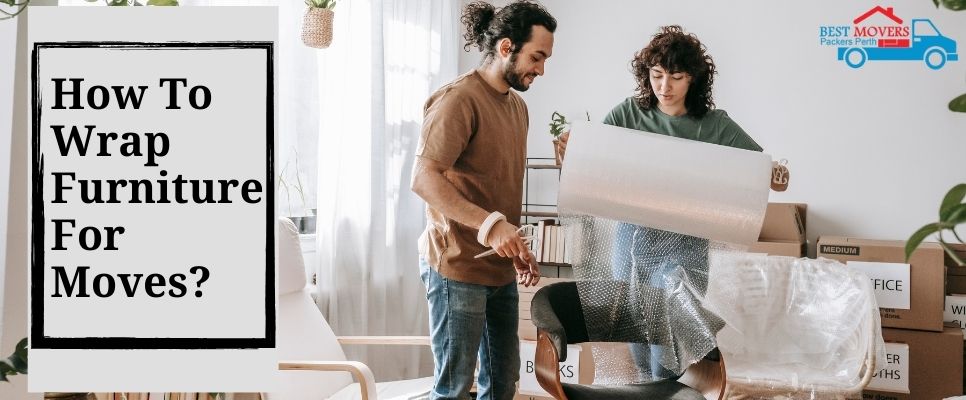How To Wrap Furniture For Moves?
During a move by wrapping furniture, have you given any attention to protecting expensive items like your beloved armchair or your couch? Some of the unexpected costs of moving include wrapping and packing supplies but you can spend your money wisely once you figure out how to wrap your belongings properly. Naturally, if you engage a local moving company, they will have wrapping materials on hand. To prevent scratches, dents, and other damages, furniture needs to be carefully wrapped. Whether a treasured heritage or a modern piece, it requires safe transportation and ensuring careful wrapping of any items. You can use the following pointers on how to wrap furniture like an expert if you’re a do-it-yourselfer. You can reduce the chance of damage with an appropriate furniture wrapping strategy.
If you want to know furniture removal cost and How To Prepare Furniture for Removalists ? than you should read our blog.

Tips And Tricks: How To Wrap Furniture
It’s imperative to make sure furniture travels unscathed while getting ready to wrap it for a transfer. You can follow these instructions to ensure that your furniture reaches its new location in perfect shape.
1. Collect wrapping and packing supplies
To ensure safe wrapping of your furniture, it’s critical to select the proper packing and wrapping materials. To protect your furniture in the shipping box or moving vehicle, these well-liked solutions are necessary.
- Wrapping bubble wrap
- Shifting blankets
- Sheets of corrugated cardboard
- Tape for packing
- Plastic wrap that stretches
- Cover for couches and mattresses
- A plastic bag that seals
2. Scrub the surface of the furniture
To start over, getting a new place to live is an exciting opportunity. You can be sure that it will be neat and orderly when you later unwrap your furniture. Take care of these cleaning duties to prevent damage to the furniture before wrapping.
- Remove any food residue from the furnishing
- Clean the glass
- Dust voids and fissures
- To clean wood surfaces, use a light furniture soap
- Spot clean upholstery fabric on furniture as needed
3. Use multiple materials to protect your furniture
Some of the materials used by both professional moving firms and do-it-yourself movers to safeguard property are stretchable plastic wrap, bubble wrap, moving blankets, and cardboard. Which combination suits you the best will depend on how much, what kind, and how much furniture you already own. Don’t be afraid to mix and match your packing materials to acquire the ideal fit.
4. Photograph your furniture before wrapping
To track the state of your belongings, a reputable moving company you’ve chosen to move your household goods will probably maintain an inventory list. Before the movers arrive, take pictures and videos of your furniture so you have a record of its state before moving. This may help you with claiming insurance amount in cases of damage.
5. Dismantle heavy furniture
Furniture that breaks down into smaller parts is easier to wrap, pack and carry. Disassemble as many objects as you can to prevent dents and nicks on your walls and door frames. Use plastic bags that can be sealed to keep the little pieces together. Tape the bags to the backs or undersides of the furniture to make sure it doesn’t get lost.
- Take off the casters knobs, and other hardware
- Take the legs off of couches and tables
- Remove glass doors to wrap individually
- Take apart the beds
6. Use stretchable plastic wrap to protect the fabric
Stretchable plastic wrap is an essential item for your move. It is adhered to both itself and the furniture to keep your furnishings safe. Because of its characteristics resembling rubber bands, it also holds drawers and doors closed throughout the transfer. The following items should be wrapped in stretchable plastic wrap:
- Locks panels, drawers, and doors that aren’t removable
- Groups together minor furniture pieces in bundles
- Keeps cloth parts safe from rips and abrasions
- Covers for sofas and mattress shields
7. Use plastic bubble wrap for select items
For the most part, bubble wrap works wonderfully, but if your furniture has a delicate finish such as faux paint or antique glass, be cautious because the plastic may adhere to it. First, layering it with packing paper, it’s a good idea to wrap the furniture in bubble wrap afterwards. Use anti-static bubble wrap exclusively on your electronics to prevent damage. You can use bubble wrap here:
- Furniture legs made of wood, if not detachable
- Glass furniture inserts that are fixed in place, such as door panels or shelves
- Furniture with decorative elements, such as carvings
- Glass furniture and tabletops
- Mirrors
8. Use Cardboard as a layer for Shock Absorption
Corrugated cardboard makes an ideal all-purpose shifting tool when a bind occurs. It inserts a layer of shock absorber between things. This is how you use your cardboard in your wrapping technique:
- Extra protection for exposed furniture sections
- Make furniture corner guards out of glass and wood
- To transfer furniture across the floor using a temporary furniture dolly
- Place mirrors and glass between two sheets
- An additional layer of defence in the moving truck between the furnishings
What Is The Best Way To Wrap Furniture For Moving
Your choices are the DIY method and the Professional method. After checking the benefits of using both methods, you can decide which one is best for you.

1. DIY Method
Start by removing any elements that can be disassembled like table legs or detachable shelves to make furniture wrapping easier through this route. Use furniture pads, moving blankets, and bubble wrap to prevent dents and scratches on the surfaces. Make sure it is snug but not too tight so as not to harm the furniture, using packing tape to secure the wrapping. For delicate items such as glass tabletops, use additional layers of bubble wrap or foam cushioning.
2. Professional Method
Professionals use specialised materials like stretch wrap or heavy-duty furniture blankets. They minimise the risk of damage during transit as they have the expertise to wrap items efficiently and securely. Professional movers have access to equipment like straps and furniture dollies.
Therefore, the optimal approach on how to wrap furniture will rely on your unique requirements, the furniture’s worth, and financial constraints. DIY wrapping might be less expensive and appropriate for smaller moves or less valued things while professional movers offer experience and convenience for larger or more delicate furnishings.
Achieve A Stress-free Furniture Move With Professionals
Although furniture moving might be stressful, by using our professionals to assist with every part of your move, including wrapping, packing, moving, and even unpacking at your new residence, you can solve the problem of how to wrap furniture. You can delegate work to reliable people and lessen the stress of moving by hiring experts while concentrating on other crucial elements of your move. You may unwind in the knowledge that skilled hands are handling your relocation, after hiring experts. With our knowledge and support, you can reduce the usual stress of moving and expedite the procedure. Whether you are moving across town or to a new city, Best Movers Packers Perth can make your relocation easier and more manageable. So, while you concentrate on getting settled in your new house, take a seat back, relax, and let moving experts take care of the wrapping and moving details.










